
BESS, Lochaber, Arbroath
Welcome & Introduction
Planning Application Consultation
Ecocel Energy (Storage) Ltd has lodged an application for Planning Permission for the development of a battery energy storage system on land at Lochaber Farm, Arbirlot, Arbroath, DD11 2NS. The application planning permission for:
‘Development of a Battery Energy Storage System with a capacity of 49.9MW consisting of battery storage containers, electrical control building, transformers, security fencing, CCTV, access, landscaping and associated works.’
A Proposal of Application Notice was submitted to Angus Council. This website shows the exhibition boards for the engagement events which were held on 25th October and 15th November 2023 at the Webster Memorial Hall, 64 High Street, Arbroath, DD11 1AW.
The public consultation event provided members of the public with an opportunity to help inform and influence the proposals and your comments on the proposals were appreciated.
What is Battery Energy Storage?
Battery storage, or battery energy storage systems (BESS), are devices that enable the storage of excess electricity which is then released in periods of high demand.
There is a national requirement to balance the peaks and troughs associated with electricity supply and demand to avoid strains on transmission and distribution networks and to keep the electricity system stable. The proposed Lithium-Ion (Li-ion) batteries would store electricity, which is then fed into the grid when required and would reduce fluctuations, thus improving stability and reducing the risk of power failures.
The use of BESS are growing at an unprecedented rate, helping to future proof Scotland’s energy system, and creating the low carbon infrastructure needed to power more of our lives with clean and reliable energy.
The proposed BESS is designed to support the flexible operation of the National Grid and the decarbonisation of electricity supply.
The battery technology type for the proposed development will meet all relevant safety standards and will ensure a high level of performance.
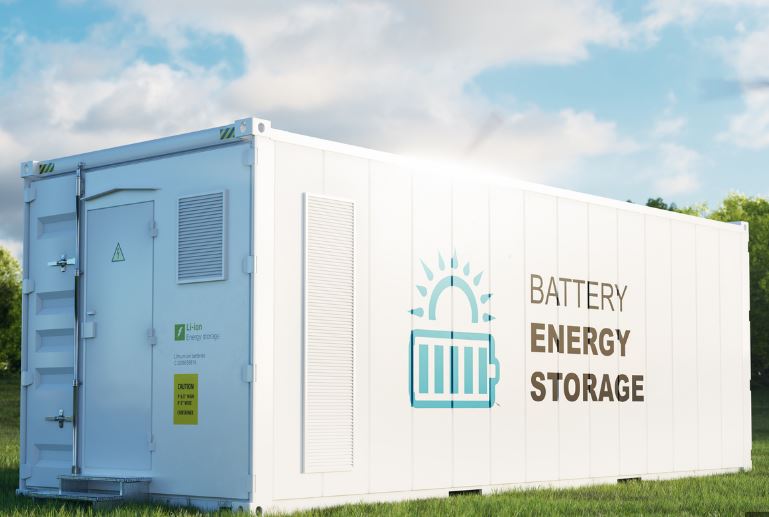

Battery Electricity Storage Systems are a key technology in the transition to a smarter and more flexible energy system and will play an important role in helping to reduce Scotland’s emissions to net-zero by 2045.
1. Department for Business, Energy & Industrial Strategy 15/10/2019 updated for Scotland’s target
About The Applicant

Ecocel started life in 2012 as Ecocel Renewables based in Hamilton. Initially we developed wind farm assets and carried out major component repair and inspection. We then moved into asset management and operations and maintenance. Our primary customers are high wealth investor groups and individuals and stringent grid network suppliers, Scottish Power, Ventient Energy, SSE and Arevon Energy.
Ecocel Energy as an offshoot of Ecocel, which runs BESS, windfarm and Hydrogen station projects across the UK.
About The Proposal
The proposal is for the erection and operation of a BESS comprising up to 40 battery storage units, electrical connection building, landscaping, security fencing, access road and ancillary infrastructure. The site covers an area of 6.29 hectares and is located on agricultural land to the northeast of Lochaber farmhouse. The land is in use of arable crop production and the surrounding area is largely rural in nature and characterised by agricultural land. The agricultural land use classification of the site is Grade 3.1, which is the second lowest classification for arable agriculture. Access to the site will be taken from the existing farm access track off the B9127.
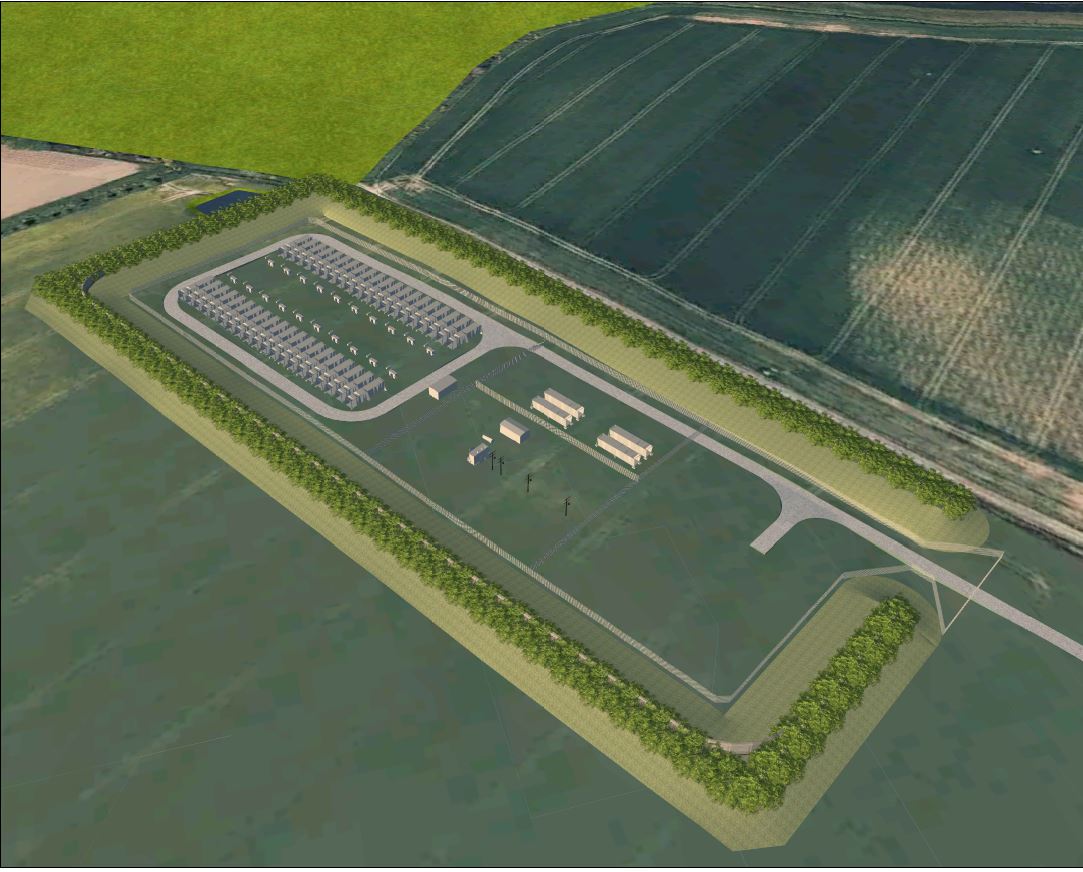
The proposed BESS development must connect to the national grid and in this instance, the intention is to connect via the existing Arbroath Grid substation, which is approximately 1.3km to the southeast. It is anticipated that connection will be by buried cables rather than overhead lines. The final route of the cable connection is yet to be determined and does not form part of the proposals.
The BESS will have an anticipated operational lifetime of 40 years capable of storing up to 49.99MW of electricity, comprising of:
- Up to 40 Battery storage containers with indicative plans showing raised units
measuring 12.2m x 2.4m, with a maximum height of 2.6m from the ground, each
with integrated air conditioning units and external inverters. The containers will be arranged in pairs with each pair sharing a small transformer etc. - Control building housing switching and electrical gear measuring 3.0m x 5.0m x 3.0m
- c.2.8m high security fencing
- 4 no. x CCTV masts with cameras
- Landscaping around the site
- Surface water drainage system
- Parking for 3 no. cars
- A new access track from Lochaber Farm
Sizes of structures are indicative only.
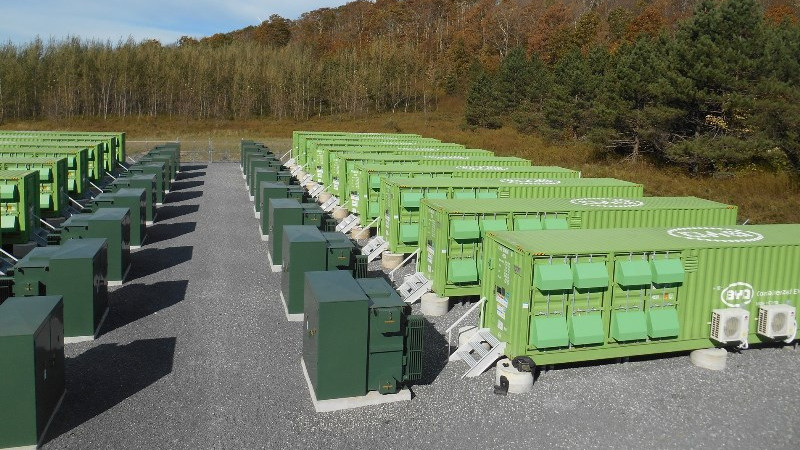
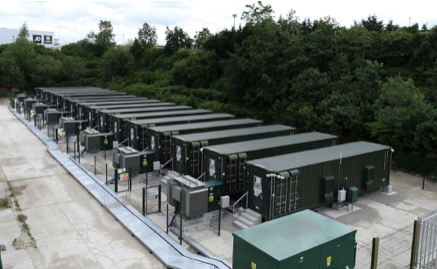
Benefits of the Development
- The development of a BESS at Lochaber Farm, Arbroath complies with the relevant Development Plan policies of the Angus Local Development Plan and National Planning Policy Framework 4.
- Direct locally sourced employment during the construction of the development. This would include: accommodation; surveying and environmental enabling works; excavation and ground works; concrete and aggregates supply; plant hire; security; landscape and site reinstatement; and mechanical, electrical and supervisory services.
- Specialist employment created during the operational phase of the development for the management and maintenance of the BESS facility.
- The proposed development is located with an isolated, rural location, away from any sensitive receptors. The closest residential properties are located over 300m away to the west (Lochaber Cottages) and to the south (Bankhead).
- The proposed BESS containers are relatively low in height and will be screened with perimeter landscape on all sides of the site to help reduce the visual impact of the proposal on its rural surroundings.
- The BESS will not result in any wider cumulative impact on the surrounding agricultural landscape.
- The BESS is located close to the existing Arbroath Grid substation, avoiding the need for lengthy transmission cables, ensuring an efficient and straightforward connection to the grid when required.
- The BESS site contains no nature conservation or heritage designations and is not within any nationally designated landscape area. There are no environmental restrictions on the site in respect of noise, air, hydrology or flood risk.
Planning Policy
The site for the proposed battery energy storage system is on the farm holding of Lochaber Farm and forms part of an agricultural field.
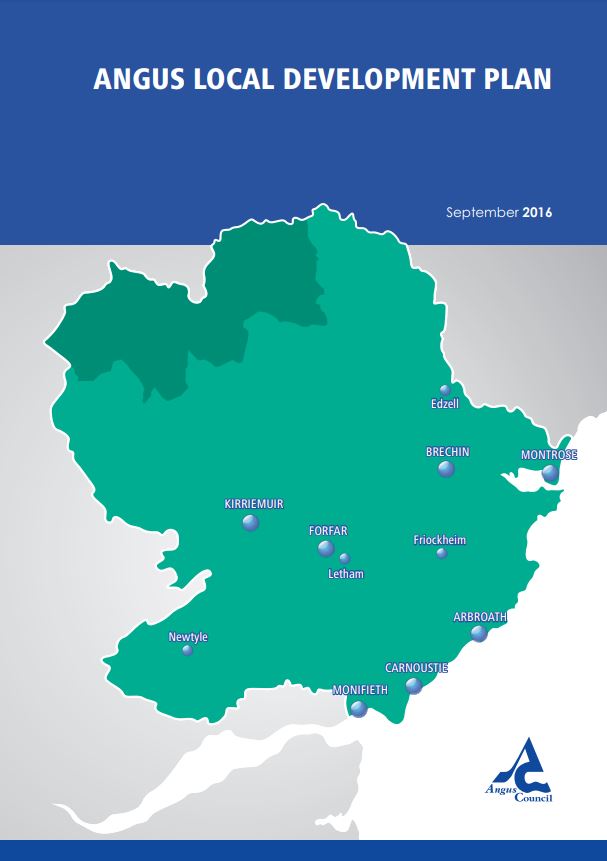
The Angus Local Development Plan – September 2016
Policy PV9 Renewable and Low Carbon Energy Development provides strong support for proposals for renewable and low carbon energy development in principle that make links to the national grid and where their location, siting and appearance of apparatus, and any associated works and infrastructure has been chosen and is designed to minimise impact on amenity, landscape and environment, while respecting operational efficiency.
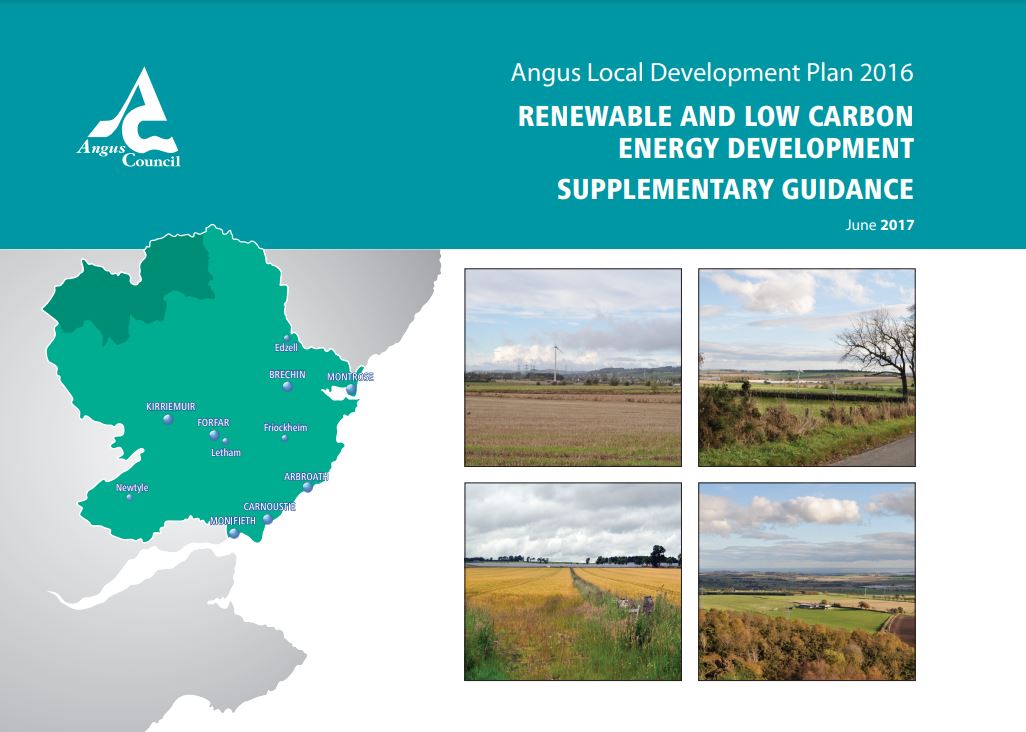
Renewable and Low Carbon Energy Development Supplementary Guidance – June 2017
This supplementary guidance supports the Angus Local Development Plan (ALDP) Policy PV9: Renewable and Low Carbon Energy Development.
It sets out criteria to assist the preparation and assessment of proposals for renewable and low carbon energy development which will be adhered to in the siting and design of the proposals for the BESS at Lochaber Farm.
National Planning Framework 4 (NPF4) sets out how the Scottish Government’s approach to planning and development will help to achieve a Net Zero, Sustainable Scotland by 2045.
Policy 1: Tackling the climate and nature crisis states that when considering all development proposals significant weight will be given to the global climate and nature crises.
Policy 11: Energy sets out the Scottish Government’s intentions to encourage, promote, support and facilitate all forms of renewable energy low-carbon and net zero emissions technologies throughout the transition to a net-zero Scotland by 2045. It states that:
“Development proposals for all forms of renewable, low-carbon and zero emissions technologies will be supported. These include:
iii. energy storage, such as battery storage.”
The proposed development at Lochaber will contribute to the objectives of the Angus Local Development Plan and NPF4, helping to meet renewable energy targets and diversifying energy supplies.
FAQs
Who is the applicant?
Ecocel started life as Ecocel Renewables based in Hamilton.
Started in 2012, the company began developing wind farm assets and major component repair and inspection. It then moved onto asset management and operations and maintenance. Ecocel’s primary customers are high wealth investor groups and individuals and stringent grid network suppliers, Scottish Power, Ventient Energy, SSE and Arevon Energy.
Ecocel Energy as an offshoot of Ecocel runs projects for battery energy storage systems (BESS), windfarms and Hydrogen stations across the UK.
Why are there so many different sites for BESS, why can't they all be located on a single site?
The BESS sites are proposed by different developers, who have made agreements with landowners in the vicinity of the existing Grid substation, which has capacity for the different projects put forward.
Concerns have been raised by residents around the visibility of the BESS and why this can't be moved further north towards the tree line and ditch?
The position of the BESS was located at the southern end of the red line boundary to minimise the length of new access track that will be required.
To address the visibility concerns raised by residents at the first consultation event, the applicant is proposing to move the BESS to the northern extent of the proposed development area.
Why was this site chosen and not a brownfield site, especially one on the industrial estate which is close to the substation as well?
Whilst a brownfield site would be preferable, none of the undeveloped sites within the industrial estate to the north east of the Grid substation are of sufficient size to accommodate the proposed BESS.
What will the batteries be used for? Does it mean we will get cheaper electricity locally?
The UK’s electricity grid has historically relied on large power plants to generate electricity. However remaining coal power plants will close by 2025 with the last Scottish one (Longannet) having closed in 2016, and existing nuclear power plants (e.g. Douneray) are reaching the end of their design lives with no new nuclear facilities being planned for Scotland. There is now a requirement to deliver an increasing amount of clean energy through renewable technologies such as offshore / onshore wind and battery storage.
The batteries will store electricity taken from the National Grid via a connection to the existing Arbroath Grid Substation located at East Muirlands Road, Arbroath. The storage of electricity is necessary to help balance the “load” on the National Grid during times of peak demand – the batteries will be charged up during periods of low demand and then release their electricity to match periods when electricity demand increases. With increasing use of wind turbines in the UK to generate energy, the batteries can help reduce the impact of “pauses” in wind energy generation (e.g. when the prevailing wind is too strong for turbines to operate safely) – reducing the call on more polluting energy systems.
Whilst the local area cannot connect directly to the batteries themselves, the increased use of these flexible storage systems will help balance out supply and demand mismatches and ultimately reduce electricity costs for all consumers.
Are there any risks to local residents from these battery units e.g. fire, explosion, gaseous emissions?
There are no risks anticipated to local residents from the day-to-day operation of the battery units. They are inert devices and there are no harmful emissions that will come from the site. The units themselves will be located approximately 400m from the nearest residential building, and whilst there is always a risk of fire from any device connected to an electricity supply (just as there is in the home) such risks are considered low. Fire suppression systems will be installed on each battery unit, with management systems also installed to monitor (amongst other things) the unit’s internal temperature. These systems would automatically be deployed if a fire was detected.
The site will be alarmed and monitored 24/7 to ensure against unauthorised access.
How long will these batteries remain onsite / in use?
It is anticipated that the battery units will be in operation for 40 years, following which the site will be returned to its previous state.
What the site will look like?
An indicative site layout was shown at the public consultation event on the 25th October and 15th November 2023 which were held at the Webster Memorial Hall, 64 High St, Arbroath DD11 1AW.
A revised layout is shown below. The SUDS pond has been scaled down to an appropriate size based on a drainage assessment and bunding provided within the landscape buffer to provide additional screening.
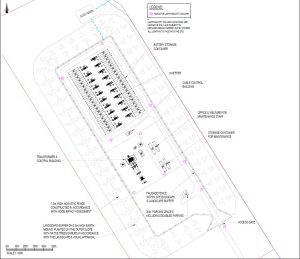
How high will the buildings be?
The development will be relatively low profile. The battery units are akin to standard 40ft shipping containers and whilst the exact height of the units is still to be finalised (as this is dependent on the supplier), the image in Figure 1 below shows a similar battery energy storage development and provides an indication of what this proposal may look like. Each battery unit is self-contained and will be delivered to the site ready for connection.
There will be one small building on the site which will be a single storey control room. The design of the building will be confirmed at the public consultation event.
Figure 1: Typical battery energy storage site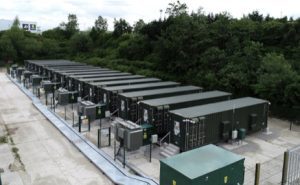
What is the proposed cable route?
The cable route from the proposed BESS to the Grid substation will be determined by SSE.
Why is the red line boundary much larger compared to the use of the site shown on the proposed site plan?
The red line boundary encompasses an area that will accommodate the proposed access, the number of battery storage units required to supply the grid connection capacity based on current proven technologies and the surface water attenuation scheme which includes a Sustainable Urban Drainage (SUDS) basin.
How long will the development take to build?
The development is guided by the date of the transmission grid connection which is 2027. The construction process will be phased with initial enabling works being carried out soon after receipt of planning permission. This will be followed by a period of inactivity until the grid connection has been made, after which the battery units will be installed. The following provides an indicative program of activities:
- Spring 2024 – Receipt of planning permission
- Spring 2024 – Autumn 2024 – site preparation including earthworks, levelling of site, development of access route and planting of all perimeter hedgerows/trees and landscaping
- Mid 2025 – Construction of equipment foundations/drainage
- Q1 2027 – Construction of control room
- Q1 2027 – Installation of battery energy storage units
- Q1/Q2 2027 – Testing and commissioning
Will there be any natural screening of the site such as trees or hedging planted?
Yes. Fencing is necessary to deter unauthorised access. The fence design will have vertical bars and be sufficiently wide to allow the passage of small animals through the site. To aid integration into the surrounding rural landscape, it is proposed that mixed native hedging and trees are planted around the entire perimeter of the site on the outside of the fencing.
The fencing on the BESS site in Arbroath is too visible as they only painted the outside of the fencing and left the inside coloured yellow. Will the same thing happen on this site?
If the planning authority require a colour of palisade fencing different to the standard galvanised zinc, then that will be made a condition of planning consent. The palisade fencing will be screened by the landscape planting, the scheme of which will be agreed with the planning authority and will become a condition of any planning consent.
What type of landscaping and planting is proposed, can more mature trees be planted?
A landscape planting scheme will be submitted as supporting information to the planning application and agreed with the planning authority. The scheme will include native species of trees and shrubs that will provide an effective screen of the BESS with trees of an appropriate mature height for the landscape setting.
The landscaping on the other BESS site in Arbroath has all been eaten by rabbits/deer and not replaced. Is the same thing going to happen here?
The replacement of landscaping and planting at the other BESS site (located adjacent to the Grid substation) is a responsibility for that developer and site owner. Planning Condition 1 iii) of their planning consent requires that any plants or trees which die, or become seriously damaged or diseased within a period of 10 years from the end of the first planting season, shall be removed and replaced in the next planting season with others of a similar size and species.
We would expect a similar planning condition to be imposed on this application by the planning authority.
Will the site create any noise whilst in operation?
A noise impact assessment has been undertaken and included within the planning application submission. Although the batteries by nature are quiet in operation, the principal noise emissions are expected to be produced from air conditioning units, inverters and transformers found on site.
What about noise during construction?
The construction phase, and any operations being carried out, will be in line with best practice guidelines and any effects will be short term.
Will there be any disruption to the Arbroath Path Network which runs alongside this site?
There will be no disruption to the Arbroath Path Network which will remain unaffected by the proposals. Construction traffic will access the site from the B9127.
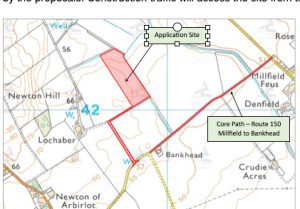
Is there any opportunity to improve the local Core Path network as a result of this proposal?
Comments have been raised by the local community regarding the possibility of joining up the core path with the core path west of Lochaber towards Cuthlie. Criticisms were that it can’t really be called a ‘network’ because the paths don’t join up. As part of the assessment of community benefits, the applicant will engage with the Angus Council Countryside Access Officer to assess whether they or the landowner can help improve connectivity of the Core Path Network in the vicinity of the site.
What will be the extent of additional traffic during the construction phase and during ongoing operations?
A Transport Statement has been prepared and is included within the planning application submission.
During the construction phase it there will be ground clearing machinery in operation, in addition to other smaller vehicles such as vans, cars etc. It is expected that the local authority may condition planning consent with the following working hours:
- 08.00 to 18.00 on Monday to Friday inclusive; and
- 08.00 to 13.00 on Saturdays;
- no construction work taking place on a Sunday or on public holidays.
Access to the site will be via the existing Lochaber Farm access track. Once the site has been prepared, the batteries themselves will be delivered to site via large lorry, with a crane also required on site to lift these into position. These larger vehicles will not be required until later in the project and then only for a short period of time.
During ongoing operations, as monitoring of the battery facility is done electronically, additional traffic will be limited to maintenance engineers carrying out site inspections to ensure the security of the facility and any ongoing maintenance.
What about the impact on local wildlife?
The site will be surrounded by high security fencing which will be regularly inspected, and there will be gaps between the vertical bar fencing to allow small mammals to cross the site.
As highlighted previously, noise from ongoing operations will be limited to air conditioning units, transformers and inverters – the noise from these is not anticipated to cause any disruption to local wildlife.
What about impact on bats and the need for an ecology survey?
Bats generally forage along field boundaries and there will be no disturbance to these other than the construction of a headwall into the drainage ditch for surface water discharge. The proposed landscape planting will improve biodiversity compared to that of arable farm land.
A Preliminary Ecological Assessment has been undertaken and submitted as supporting information to the planning application submission.
Is there any impact on the power lines which cross the field?
The overhead transmission cables that cross the fields to the south and east of the proposed BESS will not be affected.
What Happens Next?
Thank you for taking the time to review our proposals. Responses to frequently asked questions are posted above.
If you wish to make comments on the proposals, you may do so via Angus Council’s online planning portal.